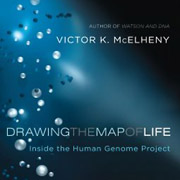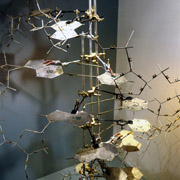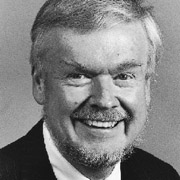Drawing the Map of Life
McElheny's new book describes how DNA will change our future



Drawing the Map of Life is the story of the Human Genome Project from its origins, through the race to order the 3 billion subunits of DNA, to the surprises emerging as scientists seek to exploit the molecule of heredity. Based on years of original interviews and reporting in the inner circles of biological science, Drawing the Map of Life is the first account to deal in depth with the intellectual roots of the project, the motivations that drove it, and the hype that often masked genuine triumphs.
Victor McElheny, Founder of the Knight Science Fellowship and currently a Visiting Scholar in the STS Program, gives insightful profiles of key people, such as David Botstein, Eric Lander, Francis Collins, James Watson, Michael Hunkapiller, and Craig Venter. McElheny also shows that the Human Genome Project is an example of how new techniques (such as restriction enzymes and sequencing methods) often arrive first, shaping the questions scientists then ask.
Talk by the Author
Harvard Book Store | July 20, 2010 | 7:00 pm
Watch on The Forum Network
Reviews | Interviews | Honors
Science | review by Angela N. H. Creager
(subscription required)
Scientific American Book Club Selection | Select "Biology" on Main Page
On June 26, 2000, in the East Room of the White House, President Bill Clinton celebrated the “completion” of a most wondrous map—the DNA that makes up the human genome. In Drawing the Map of Life, Victor McElheny outlines the events that led up to that ceremony and chronicles the torrent of efforts over the next decade to fill in the rough draft of the genomic map and interpret it. Packed with original reporting and profiles of key players, Drawing the Map of Life offers a definitive account of one of today’s greatest scientific adventures.
Salon | Interview
In his new book about the tumultuous evolution of the Human Genome Project, Mcelheny says that "the widespread impact of genome sequencing is only now beginning to be felt, and a new era of genetically informed medicine is just around the corner. Salon spoke to McElheny about the legacy of the Human Genome Project, the advent of hyper-personalized medical treatment, and how artificial chromosomes will help us fight global warming.
About
Victor McElheny
Currently, a Visiting Scholar in the Program in Science, Technology, and Society (STS), McElheny was a Nieman Fellow at Harvard (1962-1963), and has worked as a science journalist and editor for many distinguished publications, including Science, the Boston Globe and the New York Times. From 1978 to 1982, McElheny was director of the Banbury Center at Cold Spring Harbor Laboratory. He founded MIT's Knight Science Journalism Fellowships in 1982 and served as director of that program until 1998.
Founding Director, MIT Knight Science Journalism Fellowship
Visiting Scholar, Program in Science, Technology, and Society
American Scientist | Interview with Victor McElheny
Previous Books
Victor K. McElheny is also the author of two previous books, both of which were written while he was a Visiting Scholar at STS.
Insisting on the Impossible: The Life of Edwin Land, Inventor of Instant Photography (Perseus 1998)
In the first full-scale biography of this Magellan of modern technology, McElheny reveals the scope and spirit of Land’s scientific and entrepreneurial genius.
Watson and DNA: Making a Scientific Revolution (Perseus 2003)
"Victor McElheny's biography of Jim Watson....is a vivid portrait of a man who is himself an institution in our science...[and] describes well the development of Cold Spring Harbor from a sleepy, minor research institution to an active centre whose courses, books and meetings have driven the pace of scientific research in modern biology." — Nature | Review by Nobel laureate Walter Gilbert


